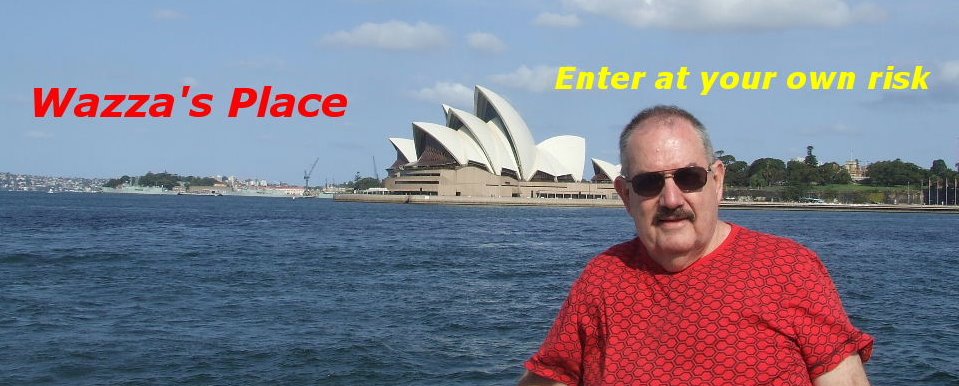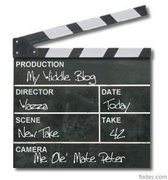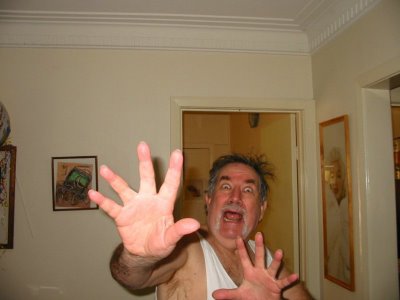Holtie and Wazza Journey to Victoria Part 1
-->
A few months ago I rang Peter (Holtie) and suggested we
should make arrangements to go on holidays to Lake Awoonga
for barramundi fishing, like there is in the rest of the state.
Due to unforeseen circumstances we had to put this trip on
hold and we decided instead to drive down south to Victoria
and visit Peter’s sister, Merle and also check out some of the
tourist sites in Victoria Victoria
30 years although Peter was often down there as a lot of
his relatives live there.

-->
We set off on a Sunday morning and our first overnight stay
was in Dubbo. This was a long journey of 890km (about 550
miles). Leaving Dubbo we travelled 800km (about 498 miles)
to Mildura where we were going to stay for a few days.
Before we arrived at Mildura we called into Parkes some
120km south of Dubbo. It was here we decided to see the
Parkes Radio Telescopic.

-->
Peter walking into the grounds of the Parkes Radio Telescope.
Since its opening in October 1961 the Parkes Radio Telescope
has been an icon of Australian science. Famous for its reception
of the television images of the first Moon walk in 1969, it is
normally used to detect the faint radio emissions from objects in space.
.jpg)
The fictional film 'The Dish' was based on the real role that Parkes
played in receiving the first video footage on the first Moon walk
by the crew of Apollo 11 in 1969. Although designed and operated
as a radio telescope for astronomical observations Parkes has also
been used for tracking and receiving data from many space probes.
.jpg)
.jpg)
-->
It has contributed to other space missions including the Galileo probe to Jupiter and the various Mars missions in early 2004. In January 2005 it was a key element in a global linkup of 17 radio telescopes observing the descent of the Huygens probe through the atmosphere of Titan. With a diameter of 64 metres, Parkes is the largest single
dish telescope in the southern hemisphere dedicated to astronomy.
Its large collecting area makes it a very sensitive instrument
ideally suited to finding pulsars, rapidly spinning neutron stars the
size of a small city. Two-thirds of the 1,800 known pulsars,
including the only binary pulsar system, were found using this telescope.
.jpg)
Photograph by John Sarkissian (CSIRO Parkes Observatory).
Mildura is a regional city in northwestern Victoria Australia
and is located in the Sunraysia region, and is on the banks of
the Murray River . The city's population is about 30,500.
Mildura is also known as the centre of Victoria
and is a major producer of citrus fruits (especially oranges),
and wine. It is also notable for its grape production, supplying
80% of Victoria

Apex Caravan Park where we stayed in Mildura.
Explorer Captain Charles Sturt arrived in the area in the 1830's
in the search for an inland sea. He entered the headwaters of a
wide river, which he named the Darling. On a subsequent
expedition he entered a mighty river, which he named the Murray
In 1830, while navigating the Murray
junction, which he was convinced was the confluence with the
Darling. Settlers and drovers began arriving in the area, bringing
cattle and sheep to graze the natural pastures.

...................................Langree Avenue in Mildura.
In 1886 George Chaffey came to Australia
derelict sheep station at Mildura as the site for his first irrigation
settlement signing an agreement with the Victorian government
to spend at least £300,000 on permanent improvements at
Mildura in the next twenty years. After much political wrangling,
the settlement of Mildura was established in 1887.
It was named after the Mildura sheep station that provided most
of the land. The name is of Aboriginal origin, and means either
"red sand" or "sore eyes"

-->
Chaffey Bridge in Mildura crossing the Murray River.
The economy of Australia
“Rode on the sheep’s back”. The simplest way to transport all that
wool to the ports on the coastline was by river. A thriving industry
of paddle river steamers arose on rivers like the Murray
this wool to ports, where it would be loaded onto ships bound for

-->
View of the Apex Caravan Park from the Murray River.
Peter’s ex Julie also lived in Mildura, so we contacted her when
we arrived and that evening we went out for dinner. I have
known both Peter and Julie for over 30 years. Julie now operates
her own quilting business where she creates her own designs.

-->
Julie demonstration how she operates the quilting machine.
The following morning we boarded the paddle boat steamer
“Melbourne” where we went on a two hour cruise down the
Murray and these are used to regulate the flow of the river
and to lower and raise the level of the river to allow the large
number of houseboats and tourist paddle boat steamers that
ply up and down the river. Here we were able to observe the
operation of the locks as we maneuvered through the locks
to get to the lower level of the river.

The Paddle Boat Steamer "Melbourne".
The Murray River
Mildura Weir pool, a distance of 970 kilometres from the mouth.
Eleven weirs with locks, each raising the water level behind it by
an average of 3.1 metres, create a continuous series of stepped pools.
.jpg)
-->
A lock is a rectangular chamber of concrete with gates at each
end. The locks permit boats to move from one level to another.
For a boat to pass downstream through the Lock, the water
inside the chamber must be at the same level as the top weir
pool, to allow the gates to open. The top gates are opened by
hydraulic powered arms to allow the boat to enter. The gates
are closed behind the boat and the water in the lock chamber
is released by opening large hydraulically operated butterfly
valves. Water flows from the lock chamber, via tunnels, to the
weir pool below. As the water level in the chamber drops, the
boat is lowered with it, until equal to the level of the lower weir
pool. The bottom gates are then opened and the boat continues
on its way. The water levels in locks are raised and lowered
entirely by gravity; no pumps are used.

.jpg)
To travel upstream the reverse occurs. After the boat enters the lock chamber and the gates are closed behind it, valves are opened above the upstream gates to fill the
chamber, via tunnels from the top weir pool. Water enters
the chamber from the tunnels through ports spaced along
the bottom of each wall. This is to distribute the inflowing
water to minimize turbulence in the lock chamber as it fills.
-->
.jpg)
When the water level in the lock chamber is equal to the
weir pool, the gates can be opened and the boat can proceed.
It takes only 7 minutes to empty or fill the lock chamber but
it normally takes 15 to 20 minutes to pass a boat through the lock.
.JPG)
Should you visit Mildura or any of the towns along the Murray
a cruise on one of the many paddle boat steamers is well worth
the experience.
-->
In Part 11 we travel onto the historic township of Echuca
was established around 1850 and is now a thriving tourist town
and a visit here is essential. We only spent a few hours at Echuca
as we wanted to be in Shepparton that evening. We would be
spending a week visiting Peter’s sister, Merle and also driving
down to the Great Southern Road to view the Twelve Apostles,
an amazing collection of sandstone pillars standing in the Southern Ocean.





7 comments:
Hi Warren ~~ I enjoyed reading about
the first part of your trip with Peter. Great job, as always with lots of pictures to illustrate.
Looking forward for part two. Hope all is well at your place, Damn hot here 41 C today - and way too hot.
Take care, Love & best wishes, Merle.
It's Robyn's birthday today, 20th.
I've been waiting so long for this post I almost missed it, well rit buddy.
Gday Warren," Happy Astralia day "
loved your email.
Just popped over to see if you had updated and Surprise, surprise.
Wonderfull post commentry and photo's on your trip with Peter trip to Victoia,,' Take care look forward to part 2... Jan
HAPPY AUTRALIAN DAY!
HAPPY AUTRALIAN DAY!
HAPPY AUTRALIAN DAY!
HAPPY AUTRALIAN DAY!
HAPPY AUTRALIAN DAY!
HAPPY AUTRALIAN DAY!
HAPPY AUTRALIAN DAY!
HAPPY AUTRALIAN DAY!
HAPPY AUTRALIAN DAY!
HAPPY AUTRALIAN DAY!
I came over to wish you a HAPPY AUTRALIAN DAY! and see that Jeanette beat me to the punch. Of course she is "Aussie" and you guys are really proud of your historical start.
I am too, for you. So, HAPPY AUTRALIAN DAY!
I thank you also for putting on this trip you and Peter did. It sound like real fun and the thing buddies should be doing.
I will check for more soon!
HAPPY AUTRALIAN DAY!
Cheers,
..
Dear Warren ~~ Thank you so much for your concern about the terrible fires all over Victoria. I am about an hour or so from Bendigo, Seymour and Beechworth. Should br safe here in town. The weather is cooler 27C a hell of a lot better than 46C on Saturday. Guess it will be known as Black Saturday - worst we have ever had. 107 dead and more to come still
Watching and reading about it all has been awfully upsetting. Thank also for the jokes - they will help
Take care of yourself, my friend, Love, Merle.
wow.. sounds like a great trip.. thanks for sharing with us.. but I bet you left out a few bits?
:-)
Della
Happy birthday Warren..how about an update.. Jen
Post a Comment